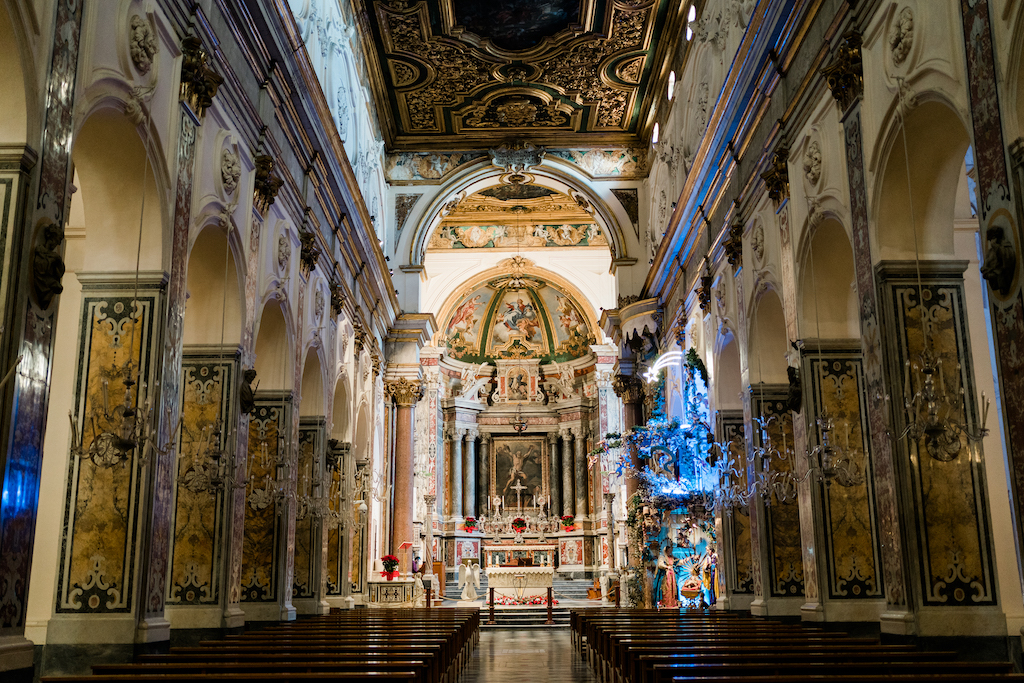Crossing the bronze portal, the Maritime Republic’s history will reveal itself. From the Knights of Malta to Ludovico di Tolosa to Sant’Andrea
January 5th, 2021. By Alessio Amato, photo by Andrea Gallucci
The Cathedral of Amalfi is now considered one of Italy’s most important and beautiful monuments, where the Byzantine style joins with the Romanesque, Islamic, and Baroque ones. The monumental complex consisting of the Duomo, the Cloister of Paradise, and the Crucifix church, the Diocesan Museum seat, has a historical and social value beyond the artistic one.
The cathedral was built in the 10th century when Amalfi excelled in the Mediterranean trade, attracting and fascinating thousands of people yearly. The structure that some artworks now preserved inside the museum have been handed down for centuries are important messages considering the problems marking the contemporary era: charity, hospitality, care of pilgrims, poverty, refusal of power and wealth, the union of religions in times of division.

The imprint of the Knights of Malta
The Cathedral of Amalfi testifies to great religious respect. Islamic lines become an integral part of Christianity in a too often repudiated harmony, a mirror of centuries of trade with distant peoples geographically and culturally.
In the Diocesan Museum of Amalfi, the Golden Fleece of the Knights of Malta’s order was founded according to tradition by Fra Gerardo Sasso di Scala. An order that was born as the Knights Hospitaller of Jerusalem to care for pilgrims in need, not just Christians, who arrived in Jerusalem.
The courage of Louis of Toulouse
A work of note is the Angevin Mithra, which belonged to the Bishop of Toulouse, Ludovico, who was proclaimed a saint in 1317. The quality and choice of materials certainly arouse interest and amazement: gold, emeralds, rubies, and drawings of almost twenty thousand tiny pearls.
However, it is the figure of Ludovico that is marvelous. Son of Charles II of Anjou, he was taken prisoner for seven years by the Aragonese king, who guaranteed him a Franciscan education. In 1295, at twenty-one, he was freed, and the following year he renounced the throne secretly wearing the Franciscan habit.
Against his will, he was appointed Bishop of Toulouse, but his works of charity and humility represent today his proper crown. Amalfi has the honor of preserving the Mithras, a symbol of wealth and pomp that Ludovico refused throughout his concise life. He died at the age of 23.

The magical Portal
The bronze portal also conveys a concept of religious respect. It was produced in Constantinople only three years after the Eastern Schism of 1054, which gave birth to the Greek Orthodox Christian movement. The bronze monument has four figures in the center: the Christ and the Virgin at the top and Saint Andrew and Saint Peter below.
The order of the models appears very interesting as Saint Andrew, the saint of reference and founder of the Orthodox, anticipates Saint Peter, a Catholic symbol. It should be noted that the relics of Sant’Andrea will arrive in Amalfi about a century and a half later.

The first Apostle
The Cathedral of Amalfi’s importance is linked above all to the relics of Saint Andrew, who, with his brother Simon Pietro, were the first apostles. According to tradition, Saint Andrew was the first elected Apostle. Even today, many Orthodox pilgrims arrive in Amalfi to visit the remains of Saint Andrew.
Just in Amalfi, you can witness Christian-Orthodox praying together with Catholic Christians in a church with Islamic solid imprints. Even today, Amalfi has kept that message of respect and peace, perhaps the most important and touching.
